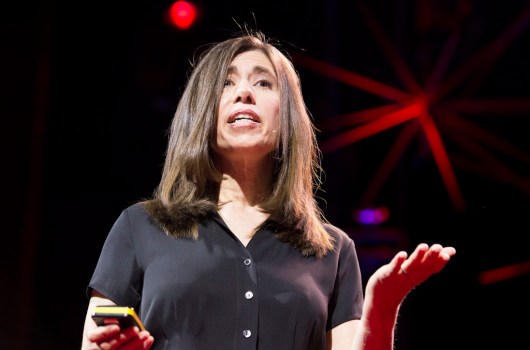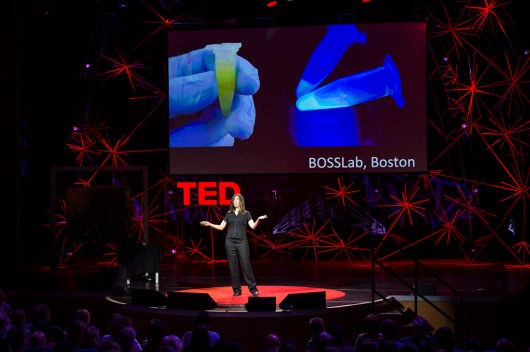“It’s a great time to be a molecular biologist,” says Ellen Jorgensen, a biologist who founded Genspace, a do-it-yourself genetics lab. By end of the year, for less than €1,000 you’ll be able to sequence a human genome in less than a day.
But, she asks: “Who gets to do it?” We know and trust the professionals — are they the only ones allowed to work with biotech? There are many benefits to a more open approach. As Jorgensen says, “If you open up the science and allow diverse people to participate, it can really stimulate innovation.”
She introduces us to “DIY bio,” open labs where you can do biology and genetics. Of course, this is sophisticated technology, and there are many social, ethical and moral questions associated with it. But she points out that the best way to engage with the topic is to learn about the subject firsthand. “Scientists are terrible at explaining what we do … Wouldn’t it be nice to have a place in the neighborhood where you could go and do it hands-on?” So she and some collaborators founded Genspace, a community lab in Brooklyn, New York. People can take classes and putter in the lab in a friendly, open environment.
It turns out that all over the world there were people trying to do similar things — opening biohacker spaces. Three years later, this is a thriving global community. Each lab has a flavor of where it was created — people work together or alone, in big cities or small villages, they build things and take them apart, and do much, much more. The spirit is open.
But what about the dark side? What about biosafety, biosecurity? The minute Genspace opened their doors, journalists called. And the only question they wanted to ask was, “Would this lab create the next Frankenstein?” The press was overestimating their capabilities — and underestimating their ethics
She points to a report recently released by the United Nations that concluded that synthetic biology has a greater capacity for good than evil. In fact, the community recently came together and agreed on a common code of ethics. That, says Jorgensen, “is more than mainstream science has done.” DYIers don’t work with pathogens, and it would be stunningly unlikely to create one by accident.
The real risks she’s taking are more personal. She signed up for the Personal Genome Project — so all of her genomic data is going to be put up online. Among the suggested possible dangers: What if someone could take that back to the lab, make some fake DNA, and plant it at a crime scene?? Jorgensen seems unworried by the (stunningly unlikely) prospect.
The other question you would ask is, “What would I do in a biotech lab?” To that, she asks us to remember when no one believed that a computer belonged on every desk. You could probably think of plenty of things to do with a biotech lab; for example:
- Figure out which dog was leaving “presents” on your street (as a journalist recently did — tossing tennis balls to each neighbordog to get a DNA sample, and cross-referencing it with the offending material).
- See if your “organic” cereal really contains genetically-modified material.
- Explore your ancestry.
- Engineer yeast to detect pollutants.
Jorgensen believes: “There is something sacred about a space where you can work on a project and not have to justify to anyone that it’s going to make a lot of money, or save the world.” And as they say in Brooklyn, “You ain’t seen nothing yet.”
In a Q&A after the talk, Chris Anderson asks her if she’s worried about a single, disturbed person intentionally creating a pathogen. She replies that, first, “It’s not that easy to create a pathogen.” And also that the idea is to create a shared sense of responsibility for all involved by empowering them. And that, finally, “The number of good guys far outweighs the number of bad guys.”


Comments (19)
Pingback: 2018年の注目は「糖質」と「バイオハック」と「自己実験」 | PR会社ランキング比較サイト
Pingback: 2018年の注目は「糖質」と「バイオハック」と「自己実験」 | PR会社ランキング比較サイト
Pingback: 2018年の注目は「糖質」と「バイオハック」と「自己実験」 | Cotton-news
Pingback: 2018年の注目は「糖質」と「バイオハック」と「自己実験」 | ニュース舛添
Pingback: 2018年の注目は「糖質」と「バイオハック」と「自己実験」 | PR会社のプレスリリースでPR会社選びをお手伝い
Pingback: 2018年の注目は糖質とバイオハックと自己実験 | コウタキ考
Pingback: 7 ways to have fun with DNA
Pingback: 7 ways to have fun with DNA | jr
Pingback: 7 ways to have fun with DNA | Best Science News
Pingback: 7 ways to have fun with DNA | BizBox B2B Social Site
Pingback: 7 ways to have fun with DNA | Health & Wellness Chicago
Pingback: Kitchen Lab: A Dutch Designer's Grand Plan For Better Health | Design For Mankind
Pingback: » Genspace at TED Global Genspace
Pingback: Personal Genome Project | Tim Batchelder.com
Pingback: Demand a more open-source government: Beth Noveck at TEDGlobal 2012 | Indoor Digital Billboards
Pingback: DIYBio @ TED Global | Manchester Digital Laboratory
Pingback: Demand a more open-source government: Beth Noveck at TEDGlobal 2012 | Krantenkoppen Tech
Pingback: The magic of a group think: TEDGlobal 2012 Day 1 recap « Content Curated By Darin R. McClure & a few photos
Pingback: atomia-site-title